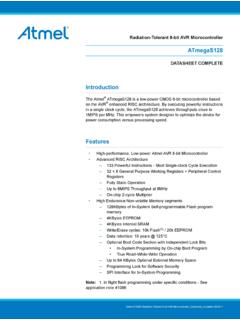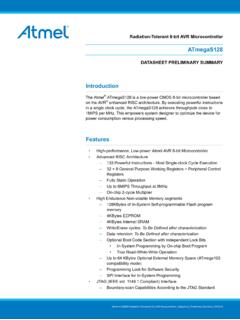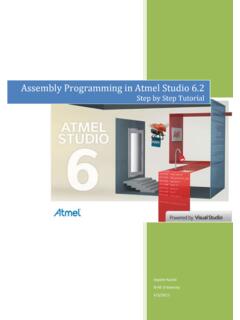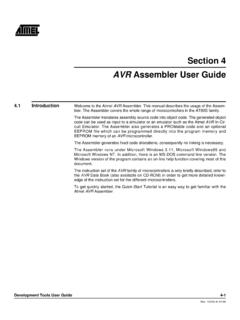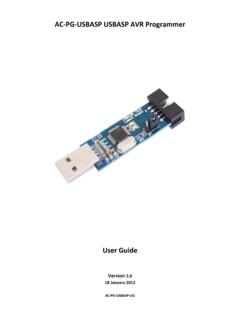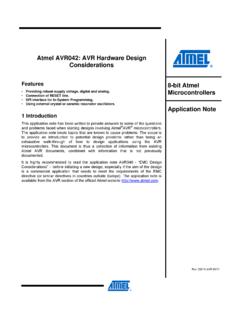Transcription of Atmel Microcontroller and C Programming: Simon …
1 Atmel AVR STK500 Atmel Microcontroller and C programming Simon LED Light Game Christopher Steiner Florida Gulf Coast University Page | 1 Fall 2009 Atmel Microcontroller and C programming : Simon LED Game Final Draft Christopher Steiner Dr. Janusz Zalewski CEN 3213 Fall 2009 - Embedded Systems programming Florida Gulf Coast University Fort Myers, Florida 12-4-09 Atmel AVR STK500 Atmel Microcontroller and C programming Simon LED Light Game Christopher Steiner Florida Gulf Coast University Page | 2 Fall 2009 1. Introduction Project Overview The purpose of this project is to take the information given by the previous work done using an Atmel AVR STK500 Microcontroller unit [MCU] and design a new use for this unit. The new use for this unit will be to design the code for a Simon type light game where the user will be presented with lit LEDs in a sequential order that they must memorize and recreate using the switches in correct order.
2 The game will have ten levels. Each level will increase the number of LEDs lit by one. If the user presses a switch out of order, LEDs 0-3 will flash twice and this represents the failure of the game. In this case the game will start over with one LED. Completion of all ten levels will be represented by walking LEDs from LED0 to LED7, then in reverse from LED7 to LED0. The game currently works as designed. Project Materials In this section the materials required in completing this project are listed and elaborated on. Also, any non-essential resources will be listed. Required Materials AVR STK500 Microcontroller Starter Kit (P/N# ATSTK500). This includes: o STK500 circuit board (shown in Figure and Figure ) o 6 wire cable for In-System programming (ISP) (shown in Figure ) o 10 wire cables for input/output ports (shown in Figure ) Atmel AVR STK500 Atmel Microcontroller and C programming Simon LED Light Game Christopher Steiner Florida Gulf Coast University Page | 3 Fall 2009 o 9-pin RS-232 cable to connect the STK500 circuit board to the host PC (shown in Figure ) o Atmel CD-ROM with datasheets and software o ATMEGA8515L 8PU Microcontroller Computer with the following specifications o Intel Core Duo Processor o 1GB of RAM o Windows XP Professional o RS-232 Port Power Supply (AC Input 100-240 Vac Max.)
3 DC Output 12 Vdc) (shown in Figure ) AVR Studio version (build 528) for writing and debugging AVR applications in Windows 9x/NT/2000/XP/Vista(32- and 64-bit) environments. (Available from Atmel s website: ) WinAVR 2009313 is a suite of executable, open source software development tools for the Atmel AVR. contains the tools for developing on the AVR. This includes avr-gcc (compiler), avrdude (programmer), avr-gdb (debugger). (Available from WinAVR s sourceforge project page: ) Atmel AVR STK500 Atmel Microcontroller and C programming Simon LED Light Game Christopher Steiner Florida Gulf Coast University Page | 4 Fall 2009 (Figure ) (Left) 6 wire cable (Right) 10 wire cable. (Figure ) RS-232 Cable male end connector to (to STK500) female end connector (to host PC). (Figure ) 100-240 Vac.
4 65A AC Max; 12 Vdc Power Supply. Atmel AVR STK500 Atmel Microcontroller and C programming Simon LED Light Game Christopher Steiner Florida Gulf Coast University Page | 5 Fall 2009 Additional Resources This list of additional resources consists of printed material and websites that furthered the understanding of the Atmel STK500 Kit and its contents. Atmel STK500 User Guide [1] (available online at ) Novice's Guide to AVR Development [2] (available online at ) AVR Instruction Set [3] (available online at ) STK500 Components The Atmel STK500 is a starter kit for designers to get a quick start into the development of code on the AVR. The STK500 circuit board includes sockets for different AVR chips, supply voltage rectifier/regulator, serial programming hardware, serial interface level converter (RS232), 8 push-button switches, and 8 LEDs.
5 The development system features In-System programming (ISP) and high voltage programming for all AVR devices. These devices are either connected directly or through extension boards. The AVR is a Modified Harvard architecture 8-bit RISC single chip Microcontroller . Atmel AVR STK500 Atmel Microcontroller and C programming Simon LED Light Game Christopher Steiner Florida Gulf Coast University Page | 6 Fall 2009 (Figure ) Overhead view of the STK500 Microcontroller unit. (Figure ) Overview of the layout of the STK500 Microcontroller unit. Atmel AVR STK500 Atmel Microcontroller and C programming Simon LED Light Game Christopher Steiner Florida Gulf Coast University Page | 7 Fall 2009 2. Problem Description Project Overview The project will be a Simon type light game where the user will be presented with lit LEDs in a sequential order that they must memorize and recreate using the switches in correct order.
6 The game will have ten levels. Each level will increase the number of LEDs lit by one. If the user presses a switch out of order, LEDs 0-3 will flash twice and this represents the failure of the game. In this case the game will start over at level one with one LED. Completion of all ten levels will be represented by walking LEDs from LED0 to LED7, then in reverse from LED7 to LED0. Assumptions The light game will operate on the Atmel STK500 Microcontroller unit. The user will understand the functionality of the game and be able to play based on documentation. There will be no need to reprogram the board once the game has been loaded into the Microcontroller unit. The game will work correctly each time it is played. Event Table Event Name Event Stimuli External Responses Internal data & state Game begins LED0 LED3 are lit to represent start of game User presses any switch from LED0-LED3 to start Game Starts Game starts First LED is lit User presses associated switch If correct, next level.
7 Else, failure of game. Atmel AVR STK500 Atmel Microcontroller and C programming Simon LED Light Game Christopher Steiner Florida Gulf Coast University Page | 8 Fall 2009 Levels 2-10 Light LEDs in sequence User presses associated switches in sequence If correct, next levels. Else, failure of game. Next level Random number is generated from 0-3 for LED User will see previous LEDs, then current LED lit Random number is saved in an array. Game failure User presses switch out of sequence User will see LEDs 0-3 flash twice Array is cleared and game starts over. Game success User presses switches in sequence User will see LEDs walk from left to right, then right to left. Array is cleared and game starts over. Use Case Diagram (Figure ) Use Case Model Use Case Descriptions Atmel AVR STK500 Atmel Microcontroller and C programming Simon LED Light Game Christopher Steiner Florida Gulf Coast University Page | 9 Fall 2009 Play Game Player turns on the Atmel STK500.
8 First random number is generated and the corresponding LED is lit. Correct Input LED is unlit and player pushes correct corresponding switch. The level advances and a new random number is generated, stored in an array and the LEDs are relit in sequence. Incorrect Input Player pushes incorrect switch. Beat 10 Levels Player pushes correct corresponding switches for all 10 levels. Win Game If the player beats all ten levels, the LEDs are lit in sequence from LED0 to LED7, then in reverse from LED7 to LED0. Array is cleared and the game starts over. Lose Game Array is cleared and LEDs 0-3 are lit, and then flash off and on again. Game starts over. Specific Requirements Functional Requirements Once the game is started, the user will be able to push any switches they wish. Only in the case of a correct switch selection will the game progress.
9 The sequence of operations should follow: o Turn game on o Press any of the SW0-3 to start the game. o First random number is generated, corresponding LED is lit. o Player selects correct switch to press. Atmel AVR STK500 Atmel Microcontroller and C programming Simon LED Light Game Christopher Steiner Florida Gulf Coast University Page | 10 Fall 2009 o Next random number is generated and all previous LEDs are lit in sequence. This will continue for ten levels. o Game restarts. o In the case of incorrect input, the game will flash all LEDs twice and the game will restart. Interface Requirements The data that is input is in the form of switches being pressed. The data that is output is randomly generated numbers stored in an array that are then used to determine which LEDs are lit and in which sequence.
10 Each data type must be calculated correctly as this is a vital function of the game. There will be a two hundred millisecond delay between LED lighting. A two hundred millisecond delay between LED flashing. A five-hundred millisecond delay between LED walking. Physical Environment Requirements The software will be run on the Atmel AVR STK500. As long as the board is plugged in to a power source, the game can be played at any location. Users and Human Factors Requirements The types of users that the system will support are players of the game. Each player must read instructions in order to understand how the game is played. The system will automatically detect correct and incorrect input as designed by developer. Atmel AVR STK500 Atmel Microcontroller and C programming Simon LED Light Game Christopher Steiner Florida Gulf Coast University Page | 11 Fall 2009 Documentation Requirements There will be a set of rules and directions printed for the player to understand the game.



